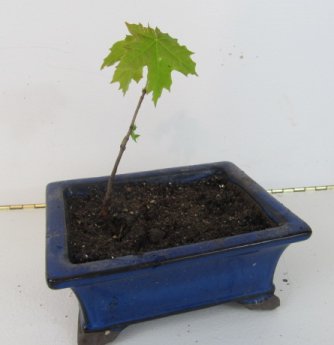One good way to start out with bonsai is to find seedlings of trees and transplant them. This is much easier and faster than starting them out from seeds. I do have a tutorial on bonsai from seed though if you prefer that method. Hunting around your local neighborhood or woods can turn up some good candidates for transplanting. There are just a few rules you should know when starting then after they have taken hold all the usual bonsai care rules will apply.
The picture above is of a maple that I have transplanted from the wild into a bonsai dish. Notice how it sits off to one side of the dish? This is pretty standard placement for bonsai in a rectangular dish. I have a selection of bonsai pots you can order through amazon.com.
Spring or Fall transplant?
If you do some research you will find there are two trains of thought when it comes to transplanting tree seedlings. For the most part people recommend you transplant a tree seedling in the autumn after the first leaf fall. And this is pretty good advice because the shock of transplanting will be reduced. The tree is getting ready for its sleeping dormant winter so it is not looking for much in terms of nutrients. But.... this more applies to larger seedlings or saplings that are a few years old. This is when you are transplanting them from one outdoor spot to another.
But.. when you are harvesting them up for placement in a pot as a bonsai I recommend you do it in spring if possible. This way you have the whole growing season to care for it and make sure it gathers up strength before it goes dormant for the winter.
Look around the area of nice healthy trees somewhere in their midlife. Very young trees and very old trees are not in their good seed bearing years. A midlife healthy tree will give you the best chances of a great bonsai.
And there can be a lot of other stuff growing around trees so try to match the leaves so you know you are getting the same tree. You could end up with a weed or something!
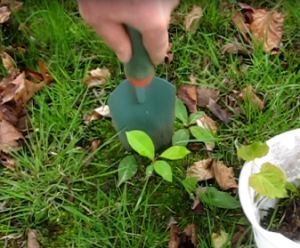
Dig all the way around the seedling with a small spade or shovel. You don't want to remove the seedling. You want to remove the whole root ball around the seedling.

Place the seedlings with root balls in a bowl for transporting them..
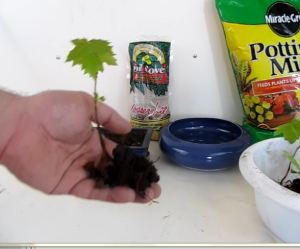
Clean up that root ball and now we are ready to transplant it.
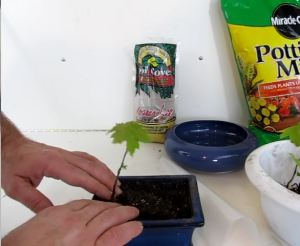
Prepare your dish or container by putting a thin layer of stones then filling it with soil. You can use potting soil or bonsai soil. I recommend you use potting soil so you get good growth in this first year.
Dig a hole with your fingers then place the root ball in it.
Fill up the hole and press it all down firmly so the seedling is firm.
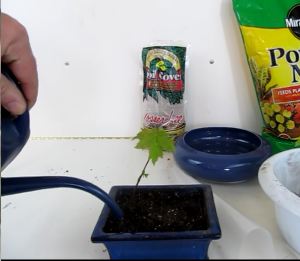
Water it thoroughly.
Monitor it closely for the first few days. Make sure it is draining well. If the soil remains soggy you will need to correct it by draining it or adding more soil.
Sunlight or Sunlamps
The tree will be sensitive for a period of time. Only give it small amounts of light at first. The first few days are critical. Try to give it indirect window lighting for an hour a day. As you see it is taking well you can expose it to more sunlight.
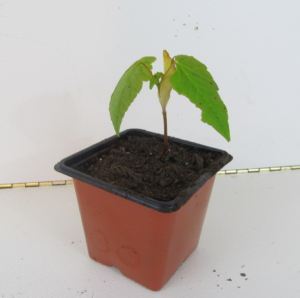
Here is another seedling that I have transplanted. It is quite ok at this stage of the process to plant it into some kind of plastic temporary container. In a year or two we can transplant it to something more permanent.
As always just make sure it has good drainage.
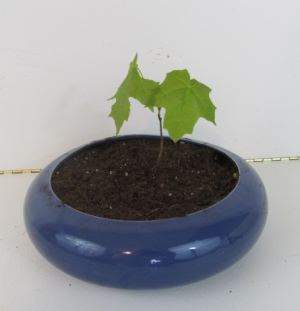
Here is another Maple bonsai seedling that I have tranplanted into a dish.
Here is another maple sapling that we have transplanted from a found seedling.
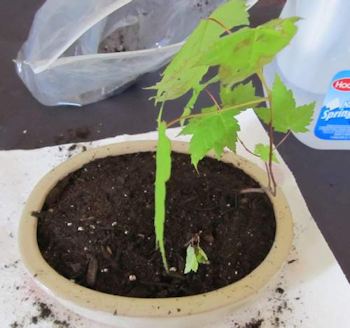
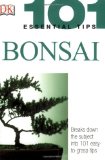 
Bonsai (101 Essential Tips)
This is a highly recommended book for starters.
Breaks down key information on cultivating bonsai into 101 easy-to-grasp tips and gives quick answers to all your questions.
Harry Tomlinson is one of Europe's leading bonsai artists and instructors. He has exhibited and judged bonsai all over the world. He is also the author of several books including DK's The Complete Book of Bonsai.
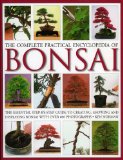 
The Complete Practical Encyclopedia of Bonsai: The essential step-by-step guide to creating, growing, and displaying bonsai with over 800 photographs This book defines and describes the ancient craft of bonsai. The techniques of this precise art form are clearly described, and provides a stunning and fully comprehensive reference that is ideal for the beginner as well as the more experienced bonsai artist. This book defines and describes the ancient craft of bonsai. The techniques of this precise art form are clearly described, and provides a stunning and fully comprehensive reference that is ideal for the beginner as well as the more experienced bonsai artist.
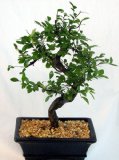
Chinese Elm Bonsai Tree - Medium by Bonsai Boy
- 10 years old specimen, 10" - 12" tall
- Recommended indoor bonsai tree, grown and trained by Bonsai Boy
- Twisted trunk and exposed roots
- Hardy tree with a great shape
|
![]()





